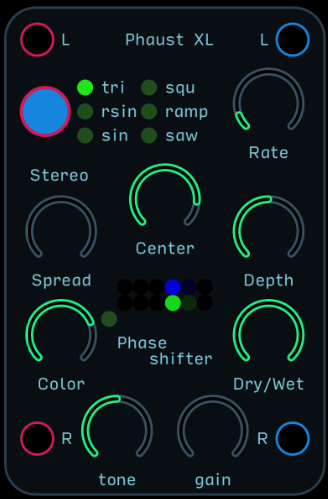I’m working on a new set of VA phase shifters (phasers) with delay-less loops and nonlinear behaviors. The aim is to capture the behavior of some classic pedals, or simply to sound realistically “analog”. After making this series of VA filters I wanted to see if it was possible to build in Audulus effects that feature a feedback loop without introducing a delay, that can be detrimental to the sound.
Phaust phaser
The first phaser of this series is an emulation of the Small Stone phaser (4 stages with feedback). I did my best to stay as close as possible to the original, so the first module is very simple. On/Off, Color mode (feedback + greater lfo depth), and lfo rate control. Again for the first phaser I wanted to stay very basic, so no need for deeper explanations. I also wanted this effect to be cpu friendly. It is mono.
The Small stone pedal is very well known among guitarists and synthesists. Here is a quick demo with the VS-305 string machine, for that famous smooth phaser sweep effect… The bassline is from the Arturia Jup-8 V4. I’ve also tested it with various instruments using Audiobus and AUM, that seems to work pretty well.
As most filters, this phaser is sensitive to the input volume. To keep sufficient headroom for the resonance, try to send an input signal at a decent volume (not to high). At high input volume the phaser will saturate, with an OTA-type saturation behavior.
Phaust XL

This is the enhanced version, fully stereo and fully controllable, and with additional lfo waveshapes.
Controls
| [Knobs, Buttons] | Function | Notes |
|---|---|---|
 |
LFO wave selection |
LFO waveform selection |
 |
LFO rate |
From 0.12 Hz to 10 Hz |
 |
LFO stereo spread |
Sets the phase offset between the R an L channels, from 0° to 180° |
 |
Center frequency |
The LFO will modulate around this frequency |
 |
LFO amount |
Defines the frequency range around the center frequency |
 |
Feedback amount |
Sets the amount of feedback, ie the resonance of the phaser. The mark represents the “color on” setting of the original pedal. So it’s possible to go beyond this point, close to self oscillation. In opposition to the original pedal, this control won’t affect the depth of the LFO. |
 |
Fx dry/wet |
From true bypass to full effect |
 |
Input signal tone adjustment |
LP filtering applied when moving the knob on the left, HP on the right |
 |
output gain |
A few comments and tips:
- The LFO waveforms are low-passed filtered, so all shapes are rounded (inspired by Maestro PS-1 phase shifter, but the original Small Stone phaser triangle waveshape was also rounded).
- The stereo spread control can be very effective, from a simple stereo widening effect with a small amount to huge stereo movements.
- You can experiment with the different waveshapes to get cool rythmic patterns, especially with the ramp waveform, but all waveshapes can give interesting results. Playing with stereo spread can also be useful here.
- Several knobs have an influence on the overall intensity of the effect: dry/wet of course but also color, depth and center
Version History
| Revision | File | Date | Notes |
|---|---|---|---|
| 1.1 | Phaust 1.1.audulus (61.0 KB) | 03/07/2021 | Initial release |
| 1.1 | PhaustXL 1.1.audulus (198.3 KB) | 03/11/2021 | Initial release |
| 1.2 | PhaustXL 1.2.audulus (198.3 KB) | 03/21/2021 | High frequencies attenuation lowered |
References
VAFilterDesign_2.1.0.pdf (native-instruments.com)
Will Pirkle Audio Technology | RackAFX6 App Notes
Spectrum analysis of the Small Stone - Bioroids - Stompbox Electronics (dedalofx.com.ar)
Maestro PS1-A Phase Shifter LFO waveform? - freestompboxes.org
